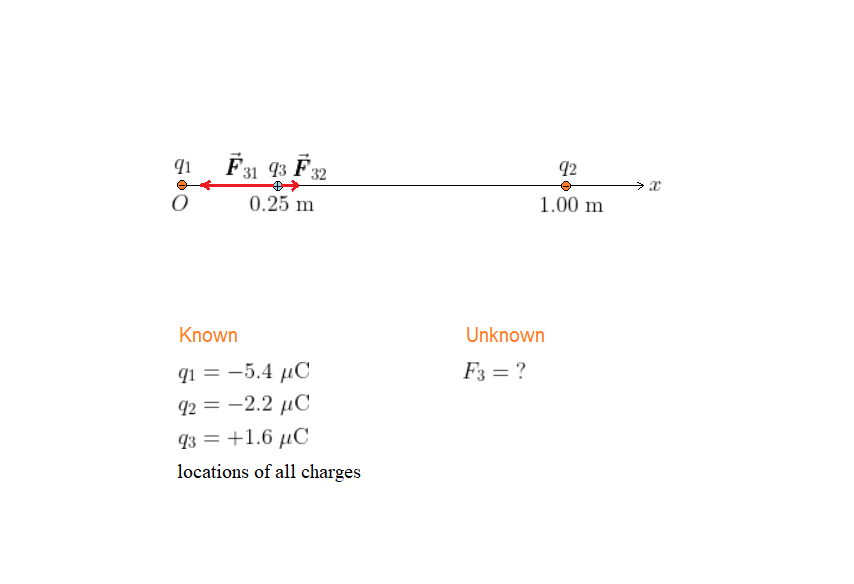
All Solutions
Page 692: Practice Problems
{color{#4257b2}text{Picture the Problem}}
$$
The situation is shown in our sketch, with each charge at its appropriate location. Notice that the forces exerted on charge $q_3$ by the charges $q_1$ and $q_2$ are in opposite directions. We give the force on $q_3$ due to $q_1$ the label $vec{pmb F}_{31}$ and the force on $q_3$ due to $q_2$ the label $vec{pmb F}_{32}$.
$$
{color{#4257b2}text{Strategy}}
$$
The total force on $q_3$ is the vector sum of the forces due to $q_1$ and $q_2$. In particular, notice that $vec{pmb F}_{31}$ points in the negative $x$ direction and $vec{pmb F}_{32}$ points in the positive $x$ direction. The magnitude of $vec{pmb F}_{31}$ is $k|q_1||q_3|/r^2$, with $r = 0.25$ m. Similarly, the magnitude of $vec{pmb F}_{32}$ is $k|q_2||q_3|/r^2$, with $r = 0.75$ m.
$$
{color{#4257b2}text{Solution}}
$$
$$
begin{align*}
vec{pmb F}_{31} &= -kfrac{|q_1||q_3|}{r^2}\
&= -(8.99times10^9;mathrm{N}cdotmathrm{m}^2/mathrm{C}^2)timesfrac{(5.4times10^{-6};mathrm{C})(1.6times10^{-6};mathrm{C})}{(0.25;mathrm{m})^2}\
&= -1.2;mathrm{N}qquad(text{negative};x;text{direction})\
vec{pmb F}_{32} &= kfrac{|q_2||q_3|}{r^2}\
&= (8.99times10^9;mathrm{N}cdotmathrm{m}^2/mathrm{C}^2)timesfrac{(2.2times10^{-6};mathrm{C})(1.6times10^{-6};mathrm{C})}{(0.75;mathrm{m})^2}\
&= 0.056;mathrm{N}qquad(text{positive};x;text{direction})\
vec{pmb F}_3 &= vec{pmb F}_{31} + vec{pmb F}_{32}\
&= -1.2;mathrm{N} + 0.056;mathrm{N}\
&= -1.1;mathrm{N}qquad(text{negative};x;text{direction})
end{align*}
$$
$$
{color{#4257b2}text{Insight}}
$$
The total force acting on $q_3$ has the magnitude of 1.1 N, and it points in the negative $x$ direction. Notice that the force due to $q_1$ is much greater than that due to $q_2$. The reason is that the charge $q_1$ has a magnitude that is about 2.5 times that of $q_2$ and it is also three times closer to $q_3$ than $q_2$ is.

$$
begin{align*}
vec{pmb F}_1 &= vec{pmb F}_{12} + vec{pmb F}_{13}\
&= +kfrac{q(2.0q)}{d^2} – kfrac{q(3.0q)}{(2d)^2}\
&= left(2 – frac{3}{4}right)kfrac{q^2}{d^2}\
&= frac{5}{4}left(8.99times10^9;mathrm{N}cdotmathrm{m}^2/mathrm{C}^2right)timesfrac{(12times10^{-6};mathrm{C})^2}{(16times10^{-2};mathrm{m})^2}\
&= 63;mathrm{N}qquad(text{to the right})
end{align*}
$$
So the separation of charge $q_2$ from $q_1$ and $q_3$ is $d=0.16:m$.
The magnitude of the force on $q_2$ due to $q_1$ is
$F_{21} = k dfrac{|q_1| |q_2|}{d^2}$ where $k = 8.99 times 10^9:N.m^2/C^2$.
So, $F_{21} = dfrac{8.99 times 10^9 times 12 times 10^{-6} times 24 times 10^{-6}}{0.16^2}$
$F_{21} = dfrac{8.99 times 12 times 24}{0.16^2} times 10^9 times 10^{-6} times 10^{-6} = 101.14:N$
Since both charges are of opposite kind, this force is an attractive force and points in the negative $x$-direction. That is,
$vec{F}_{21} = – 101.14 hat{x}$
The magnitude of force on $q_2$ due to $q_3$ is
$F_{23} = k dfrac{|q_2| |q_3|}{d^2}$
So, $F_{23} = dfrac{8.99 times 10^9 times 24 times 10^{-6} times 36 times 10^{-6}}{0.16^2}$
$F_{23} = dfrac{8.99 times 24 times 36}{0.16^2} times 10^9 times 10^{-6} times 10^{-6} = 303.42hat{x}:N$
This is also an attractive force and the force points along the positive $x$-direction. So, $vec{F}_{23} = 303.41:hat{x}$
The net force on $q_2$ is
$vec{F}_2 = vec{F}_{21} + vec{F}_{23} = -101.14: hat{x} + 303.41: hat{x} = (-101.14 + 303.42) :hat{x} = 202.28:hat{x}$
So the magnitude of the net force acting on $q_2$ is $202.28:N$ and it points along the positive $x$ direction.

When the separation between charges is increased three times the magnitude of the force on $q_2$ decreases as follows.
$F’_2 = dfrac{F_2}{3^2} = dfrac{202.28}{9} = 22.48:N$
This is because the force is inversely proportional to the square of the separation between them.
The direction remains unchanged.
(b)The direction remains unchanged.
Haven't found what you were looking for?
Search for samples, answers to your questions and flashcards

